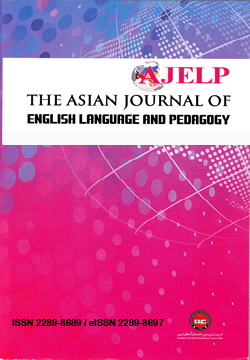The relationship between collocation competence and writing skills of EFL learners
DOI:
https://doi.org/10.37134/ajelp.vol8.1.5.2020Keywords:
collocation competence, writing skills, collocational knowledge, lexical collocations, EFL learnersAbstract
This paper aims to highlight the importance of collocations in learning English as a foreign language. Learning collocations is deemed crucial for it enables EFL learners to position words in suitable context and use them appropriately. A word may not be correctly utilised or understood unless one is familiar with the immediate context in which the word is used. Furthermore, collocations are regarded as an important factor in communicative competence and in determining learners’ level of proficiency (James, 1998; Nation, 2001). The current study aimed to explore the effects of students’ knowledge of collocation on their writing production. The participants were 20 Djiboutian postgraduate students undergoing their studies in one of the higher learning institutions in Malaysia. Using a multiple-choice test consisting of 60 items and a writing test, this study sought to investigate the correlation between lexical collocation knowledge and writing skills of the Djiboutian students. The results from the study revealed a positive correlation between the collocational knowledge and writing production. It was also found that Djiboutian EFL learners did have difficulties in English lexical collocations. These findings corroborated the need for EFL students to learn lexical collocations in order to develop their writing skills. The outcomes of this study provide useful lessons to foreign language learners, teachers, curriculum designers and material developers in the teaching and learning of English as a foreign language.
Downloads
References
Ahmed, Zinab Ali Aboulgasem. English Lexical Collocation Knowledge of Libyan University Students. Bangor University (United Kingdom), ProQuest Dissertations Publishing, 2012. 10089566.
Almalki, S. (2016). Integrating Quantitative and Qualitative Data in Mixed Methods Research - Challenges and Benefits Journal of Education and Learning; Vol. 5, No. 3; 2016.
Alsakran, R. A. (2011). The productive and receptive knowledge of collocations by advanced Arabic-speaking ESL/EFL learners. Unpublished MA dissertation, Colorado State University, USA.
Benson, M., Benson, E., &Ilson, R. (1986b). Lexicographic description of English, 24. Amsterdam/Philadelphia: Benjamins.
Benson, M., Benson, E., &Ilson, R. (2010). The BBI Combinatory Dictionary of English. Amsterdam: Benjamin.
Bowen, G., Lin Z. & Ziyan L.(2019). A Corpus-based Study of Coolocation Production of Chinese EFL Learners. International Journal of Education. ISSN 1948-5476 2019, Vol. 11, No. 4.
doi:10.5296/ije.v11i4.15895
El-Dakhs, D.A. (2015). Collocational Competence in English Language Teaching: An Overview. SSRN Electronic Journal 6(1):68-82.
DOI:10.2139/ssrn.2834432
Eshghinejad, S. (2016) EFL Students’ Attitudes toward Learning English Language: The Case Study of Kashan University Students. Cogent Education, 3, 1-13.
https://doi.org/10.1080/2331186X.2016.1236434
Firth, J. R. (1957). Papers in linguistics, 1934-1951.London, Oxford University Press.
Granger S.& S. Tyson (1996). Connector Usage in Native and Non-native English Essay Writing. World Englishes 15/1: 17-27.
Haiyan Men. (2015). Vocabulary Increase and Collocation Learning. China: Springer
Hatami, S. (2015). Collocations of Farsi L2 Leaners of English: The role of Proficiency and L1 Language Transfer. Master thesis in English Linguitics. The Artic University of Norway.
Henriksen, B. (2013). Research on L2 learners’ collocational competence and development – a progress report. EUROSLA MONOGRAPHS SERIES 2 L2 vocabulary acquisition, knowledge and use, 29-56
James, C. (1998). Errors in Language Learning and Use: Exploring Error Analysis. New York: Addison Wesley Longman Limited.
Krashen, S. (1998). Comprehensible output. System, 26, 175–182.
Kim, D. H. (2009). A study on the use of lexical collocations of Korean heritage learners: identifying the sources of errors. Unpublished thesis. University of Southern California, California.
Koosha, M., & Jafarpour, A. A. (2006). Data-driven Learning and Teaching collocation of prepositions: The Case of Iranian EFL Adult Learners. Asian EFL Journal, 8(8), 200-216.
Milton, J. (2009). Measuring Second Language Vocabulary Acquisition
Namvar, F. (2012). Analysis of collocations in the Iranian postgraduate students‟ writings. The Southeast Asian Journal of English Language Studies, 18(1), 11 – 22.3.
Nation, I. S. P. (2001). Learning vocabulary in another language. Cambridge; New York: Cambridge University Press.
Obukadeta, P. (2019). Collocations in a Leaner English Corpus: Analysis of Yoruba- Speaking Nigerian English Learners’ Use of Collocations. Doctoral Thesis Kingston University London.
Oxford, R. and Scarcella, R.C. (1994). Second Language Vocabulary Learning among Adults: State of The Art in Vocabulary Instruction System, 22 (2) (1994), pp. 231-243
Shannen-Baker, P. (2016). Making Paradigms Meaning in Mixed Methods Research. Journal of Mixed Methods Research 2016, Vol. 10(4) 319–334
DOI: 10.1177/1558689815575861
Shehata, A. (2008). L1 Influence on the reception and production of collocations by advanced ESL/EFL Arabic learners of English. Published Master Thesis. The College of Arts and Sciences of Ohio University, Ohio.
Wilkins, D. (1972). Linguistics in language teaching. London: Arnold
Downloads
Published
Issue
Section
License
Copyright (c) 2020 UPSI Press

This work is licensed under a Creative Commons Attribution-NonCommercial-ShareAlike 4.0 International License.





